The Consulate of Mexico
Towards the end of the 16th century a group of merchants who had arrived in New Spain as independents or agents of export companies in Seville. in a meeting with the town hall decided to write to the King asking him to institute a consulate similar to those already existing in Burgos and Seville. This, they explained, would solve several doubts and differences of opinion regarding trade between these entities. lt seems that most differences and doubts arose among their counterparts in Seville who had monopolized the market and the only way to counteract their power and make themselves independent was through their own consulate.
When the King learned about this petition, in a letter dated 9 June 1590, he asked the Viceroy and his council in Mexico for their opinion regarding the establishment of such a consulate. The answer must have been favourable as on 15 June 1592, Phillip II in a royal decree granted the privilege, thus creating the first chamber of commerce in Spanish America.
On 13 March 1593 the council received the royal decree and delivered it to the AudienciaAudiencia: A Judicial tribunal established to administer royal justice. In Spanish Colonial America, this was one of the most important governmental institutions, taking care of criminal, civil and ecclesiastical matters. for its confirmation. On 29 March an agreement was pronounced whereby it promised to obey the royal mandate and to give further instructions once the president and the judges had studied the bylaws that existed in Seville and Burgos. On May 17 an accord was reached and the Audiencia authorized the creation of the Court of the council supplying it from the beginning with a court of appeal under the administration of a judge, named by the Viceroy.
The royal decree was proclaimed aloud on 23 and 25 and on 3 and 4 January 1594 another proclamation summoned all wholesalers to a meeting on 7 January to appoint delegates.
On that day the electoral body was chosen and it met the next day to elect their officials. The meeting was interrupted due to an accusation presented to the Audiencia that the electoral body had admitted retail merchants to its group, contrary to its bylaws. The Audiencia could find no proof for the accusation and the membership of the electoral body was approved on 11 Juanuary. Gordian Casasano, appointed judge of appeal, then summoned the chosen for the next day and in a meeting with 23 members present the officials were chosen and voted in. Diego Hurtado de Peñaloza became the first Prior and Juan de Astudillo the first Consul, with Domingo Hernandez as second Consul. They were immediately sworn in and later five deputies were elected, to assist the Prior and the Consuls in the administrative duties.
Thus the Consulate in Mexico, like those in Spain and in other parts of the world, was born out of the desire of a group of merchants anxious to protect their interests through corporate action, and with an independent judicial power. This privileged group began its life in 1594 negotiating and signing a contract with the boatmen of Veracruz whereby all unloaded merchandize would be brought to Mexico City. Since the beginning of the colonial epoch this had always constituted a problem as Veracruz represented the key to the commercial entry to the colony and the boatmen always refused to make themselves responsible for the merchandize and much less to bring it to the city. However, with this contract the consulate almost monopolized its transport.
In 1602 a registry was signed to the effect that the consulate was to collect all sales tax in Mexico City and its vicinity. In exchange the consulate would contribute 150,000 to the Crown per annum regardless of the amount collected. This disposition also served to get rid of all official tax collectors, not too friendly towards the council.
In 1635 the consulate granted a subsidy of 600,000 to the Crown in exchange for solving the irregularities in the Peruvian and Philippine trades. Through the Manila Galleon these people controlled the Philippine trade with New Spain and the problem consisted in the Peruvian contraband to Mexico.
Furthermore the consulate, thanks to its economic solvency, began to monopolize agriculture as the mayors underwrote credits in merchandize against harvests in their hands when entering the city.
In 1720, when the Jalapa fairs were established, the consulate confronted its counterparts in Seville and later those of Cadiz from which it snatched the monopoly of sales of merchandize in New Spain, First in the interior through sales tax, later by purchasing the major part of the cargo in the port or at the Jalapa fair and several times through contraband. Although they themselves protested, it was mainly they who flooded the market with merchandize in order to force the merchants from Seville and Cadiz to lower their prices and since the latter had to sail back, they invariably ended up acceding.
Another profitable business was to hoard the currency in circulation later to export it to Spain through a contract whereby they would receive 10 reales for every 8 reales piece. In Europe where silver was scarce they went for 12 reales. This is why coins were so scarce in New Spain during those years. In a dispatch to the Viceroy in 1770, the consulate complained about the habit of small establishments tminting their own copper coins redeemable only in their stores, thereby hurting general business (The curious thing about the complaint is that the people of the consulate hoarded even fractional silver coins).
The Consulate, besides being granted concessions and privileges, also took part in construction work and charity. It built hospitals and churches and participated in the sewage construction in the City of Mexico. lt paid a heavy subsidy to the Court of Order (the police during the 18th and 19th century) and from its initiation formed a guard for the road between Veracruz and Mexico and later another between the city and Acapulco.
With the Bourbon reforms as introduced by Phillip V and executed by Charles III, the Consulate began to see its power and profit reduced whereby the big storekeepers started to invest in mining and haciendas. with the result that huge mining companies were formed.
With the Bourbons began the decline as the fleets were suspended. The merchants were no longer allowed to celebrate contracts with the mayors and the opening of all Spanish ports to free trade produced a tidal wave of merchandize available in the Mexican markets thereby ending the monopoly both here and there.
The proclamation pieces of the Consulate all belong to the Bourbon Dynasty.
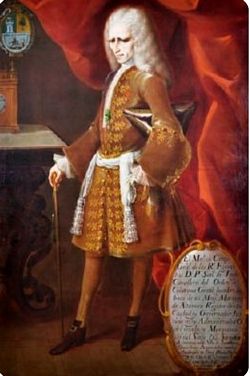 There are no known proclamation pieces of the Consulate for the proclamation of Philip V in 1701. However, the chronicle of this swearing-in ceremony says that the Prior of the Consulate, Pedro Sanchez de Tagle, together with the Consuls had several medals with the bust of the new monarch minted and that these were distributed in the vast territories of New Spain by the captains of the court.
There are no known proclamation pieces of the Consulate for the proclamation of Philip V in 1701. However, the chronicle of this swearing-in ceremony says that the Prior of the Consulate, Pedro Sanchez de Tagle, together with the Consuls had several medals with the bust of the new monarch minted and that these were distributed in the vast territories of New Spain by the captains of the court.
Nor do we know of proclamation medals struck in 1724 for Louis I by the Viceroy of New Spain, Juan de Acuña y Benavides, Marquis of Casa Fuerte.
[images needed]
Obverse, an armored bust of Fernando to the riight, with a wig, and wearing the Order of the Golden Fleece.
FERDINAND. VI.D.G.HISPA ET INDIAR.REX
Reverse, a coat of arms of the Consulate.
CONSVLAT.MEX.IN EIVD PROCLAMAT.1747
[images needed]
Obverse, an armored bust of Fernando to the riight, with a wig, and wearing the Order of the Golden Fleece.
FERDINANDVS. VI.D.G.HISPANIARUM.REX
Reverse, a coat of arms of the Consulate.
IMPERATOR INDIARUM.
On the exergue, in two lines
CONSVLATUS 1747
Divided by the shield of the coat od arms
ME XI
On 11 February 1747 the first count of Revillagigedo, Viceroy of New Spain, left his house followed by a numerous entourage composed of members of the courts and the nobility to hoist the banner for the new monarch, to thunderous acclamation. Here for the first time appear the proclamation medals of the Consulate as the Prior, Domingo Gomendio de Urutia, ordered 3,000 pieces struck in silver and 100 in goldAccording to Perez Maldonado, p. 46, 3,000 silver and 100 gold medals were thrown to the croed in the proclamation ceremony.. The obverse carries the bust of Ferdinand VI and the reverse the coat of arms that had been conferred on the Consulate by King Phillip III in 1603, namely “a Royal crown above a divided shield where one can see a vase with Madonna lilies symbolizing the pure conception of the forever Virgin Mary, our Lady. Also the five wounds of the angelic father San Francisco, patrons of this distinguished court.”
[images needed]
Obverse, a half-length figure of Fernando to the riight, with a frock coat, and wearing a wig and hat.
UIVA. EL. SENOR.DON, FERINANDO.VI.
Reverse, a closed helmet facing to the left, a sword, gun, lance and flag.
EL COMERCIO. DE GUARALAXARA. 1747
On 14 October 1747 Ferdinand VI was proclaimed in Guadalajara. The merchants of this city distributed these medals among themselves as among the nobility. In a certain way they began to show signs of wanting their own consulate as their merchants depended on a sub council of the one in Mexico City.
When Ferdinand died on 10 August 1759 his half brother Charles III ascended the throne and was proclaimed in New Spain in 1760. He and his ministers were to cause the monopolizers of the consulates in Spain and America several strong headaches. As they were under pressure due to the increasing threat of English power and economic decay at home, they practised several reforms of a political, administrative and economic character. In politics they tried to recuperate for the Crown the powers that the Hapsburgs had delegated to groups and corporations such as the consulates of the merchants, the Church, the landowners, etc. As for administration, the reforms were meant to create a modern state with more efficient institutions managed by civil servants loyal to the royal power and well trained in their jobs. Economically speaking, the reforms were meant to revive the decaying Spanish economy by making the American colonies finance it more decisively. The laws of 1765, 1774, 1778 and 1789 became the mortal blow to the consulates as they did away with the principal sector monopolizing both in Spain and in America.
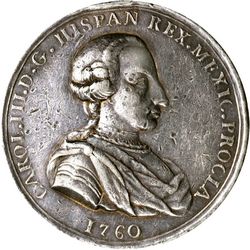
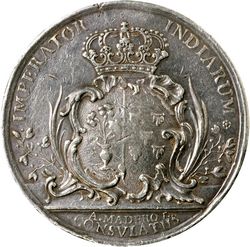
Obverse, an armored bust of Carlos to the right, with a wig and sash.
CARL.III.D.G.HISPA.REX.MEXIC.PROCL. 1760
Reverse, a coat of arms of the Consulate
IMPERATOR INDIARUM
On the exergue, in two lines
A. MADERO F. CONSVLATUS
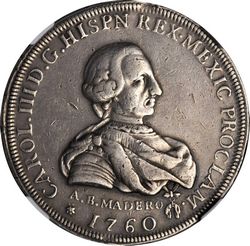
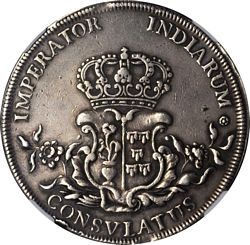
Stack’s-Bowers Online Auction, 14 February 2019, Lot 71551
We know of two types of medals from 1760, both with the bust of the monarch on the obverse and the coat of arms on the reverse. The engraver's name is A. Madero. But the curious thing is that one of the pieces has an edge legend reading: "MERCIBUS MERCEDIBUS CONSULIT VIRGA AEQUITATIS VIRGA REGNI SUI" (with the sceptre of equity, which is the royal sceptre, he favored the merchants wíth concessions). How wrong they were. The Prior at the time was Jacinto del Barrio.
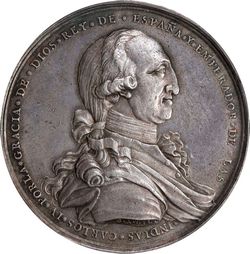

Grove C=26A. Stack’s-Bowers Online Auction, 2 March 2023, Lot 72032
[images needed]
Obverse, a laureated, undraped bust Carlos to the right.
A CARLOS IV REY DE ESPAÑA Y DE LA YNDIAS
Below the bust is small letters
A.11.de.abril.de.1790.
Reverse, a coat of arms of the Consulate
A SU PROCLAMACION EL CONSULADO DE MEXICO
On the exergue
AÑO DE 1789.
On 16 December 1789 it was announced that the fidelity towards the new King, Charles IV, was to be sworn on 27 December. The Viceroy, Juan Vicente de Guemes Pacheco de Padilla, second count of Revillagigedo, who had barely arrived hurried to organize the festivities. The Prior of the consulate, Juan de Castaniza, first Marquis of Castaniza, in consultation with his colleagues had four beautiful pieces struck. On the obverse the bust of Charles III and on the reverse the coat of arms of the Consulate in the middle and to the right Mercury, god of commerce and of the thieves as well and to the left a boat. The engraver was Gerónimo Antonio GilGerónimo Antonio GilGerónimo Antonio Gil.
During the rule of Charles IV the Consulate carne under heavy attacks by the Viceroy Revillagigedo, as he i accused the Consulate of wanting to subordinate the Spanish economic interests as well as the Mexican ones in favour of a handful of wealthy merchants residing in the city. He suggested the complete abolishment of the Consulate or that at least others be established in all principal cities of the colony. At the same time the public prosecutor, Ramon de Posada, directly accused the Consulate asking "if the wellbeing of one city is to be preferred over two hundred, if the majority of this opulent empire ought to be sacrificed in the interest of a few rich merchants" and indicated that the investments in agriculture and mining was a favourable result of the free trade. Also during the rule of Charles IV two more consulates were set up, that of Veracruz and that of Guadalajara in 1795.
When on 28 June 1808 Mexico learned how people in Spain had taken up arms against the troops of Napoleon, people rushed to the streets cheering and proclaiming Ferdinand VII swearing to defend him to the death. The Viceroy was José de lturrigaray who found himself in between two parties; the creoles who dominated the town hall and the Spaniards who represented the economy, the nobility and the power.
In 1808 it became an open conflict between the two parties; The night of 15 September 1808 Gabriel Yerno, in front of several merchants and the troops of the Consulate, penetrated the Palace and took the Viceroy prisoner. He and his family were sent to the convent of San Bernardo. Command was handed over to an old soldier called Pedro Garibay on an interim basis and the Viceroy was returned to Spain where he died several years later.
The only proclamation medal known, dated 1808, is on behalf of the Consulate in Guatemala which besides proclaiming Ferdinand VII also celebrated the 14th anniversary of its foundation.
[images needed]
Obverse, a a bust of Fernando to the right, with a sash, and wearing the Order of the Golden Fleece.
AMADO FERNANDO VII. EL COMERCIO DE N.E. DERAMARA GUSTOSO SU SANGRE EN TU DEFENSA.
Reverse, standing figures of Mars and Mercury
LA INDUSTRIA Y EL UALOR SE UNIRAN EN DEFENSA DEL MONARCA.
On the exergue, in three lines
TOMAS SURIA EN MEXICO, AGOSTO DE 1809
This proclamation medal dated 1809 was minted by the commerce of the City of Mexico. On its obverse Ferdinand VII and the reverse showing Mars, god of war and Mercury, god of commerce. This piece was engraved by Tomas de Suria.
On 21 October 809 the Guatemala gazette publishes the following notice:
"Prospectus for a medal to manifest to prosperity the praiseworthy disposition of the commerce of New Spain to taking arms to the defence of the most beloved of monarchs, Ferdinand VII."
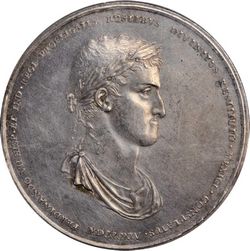
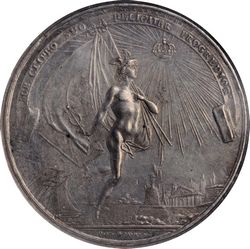
F-30 Silver medal (Stack’s-Bowers Online Auction, 28 February 2020, lot 71224)
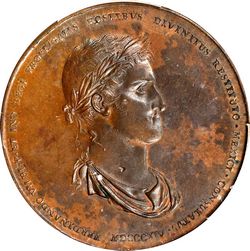
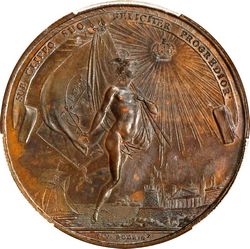
F 30A Bronze medal (Stack’s-Bowers Online Auction, 19 May 2023 , lot 70164)
The only medal minted on behalf of the Mexico City Consulate is that of the return of Ferdinand VII dated 1814. On the obverse is the bust of the king but on the reverse for the first time the coat of arms of the Consulate disappears and in its place remains only Mercury. The medal was engraved by P.U. Rodríguez.
Iturbide
The Consulate in Guadalajara, established by royal decree of 6 June 1795, had elected as its first Prior Juan Lopez Portillo and as Consuls Ignacio de Estrada and Juan José Camboro. They did not mint any proclamation pieces for Charles IV or Ferdinand VII. But once Mexico became independent, they enthusiastically organized great festivities beginning on 11December 1822 for the proclamation of emperor Agustín de lturbide.
[images needed]
Obverse, a a bust of Agustín, in a uniform dress coat with a high collar, wearing an ermine robe of Stare and the Gran Collar
and sash of the Orden Imperial de Guadalupe..
AGUSTIN PRIMER EMP CONSTITUCIONAL D M
Reverse, within an ornate border, above floral adornments and below a radiant crown, in four lines
EL CONSULADO NACIONAL DE GUADALAXARA 1822
Engraver, on the obverse, below the bust
V MEDINA F
The Consulate ordered medals struck and distributed as follows: six gold and 12 silver for the emperor, two gold and four silver for the Captain General, one gold and four silver for the bishop and four of silver each for the provincial deputies, six for the intendent, six for the constitutional mayor of first election and four each for the members of town hall, three for the dean and two each for the capitulars, three for the minister in charge and two each for the remaining members of the court; three for the university, four for the Consulate, one for each chief and employee in public office and other authorities and several to be thrown to the public at the act of the swearing-in ceremony. This piece was engraved by someone called Medina.
lturbide dernanded compulsory loans from the consulates of the newborn Mexican empire to the tune of 600.000 pesos and in order to guarantee the payment of the loan, he granted the Consulates a right to collect 2 % of all minted silver and gold from all custom agencies. But when lturbide fell, the Consulates had to give up collecting the loan and on top of it all the sovereign congress now solicited a new loan from the Consulates.
When the Mexican Constitution was proclaimed in 1824, these institutions carne to a close, as in a decree by the Congress of 16 October 1824 all mercantile courts were to cease their existence, thereby ending 234 years of life for the Consulate in Mexico.
(based on Carlos Ruiz T, Proclamation Medals from the Consulate in Mexico, 1980)
